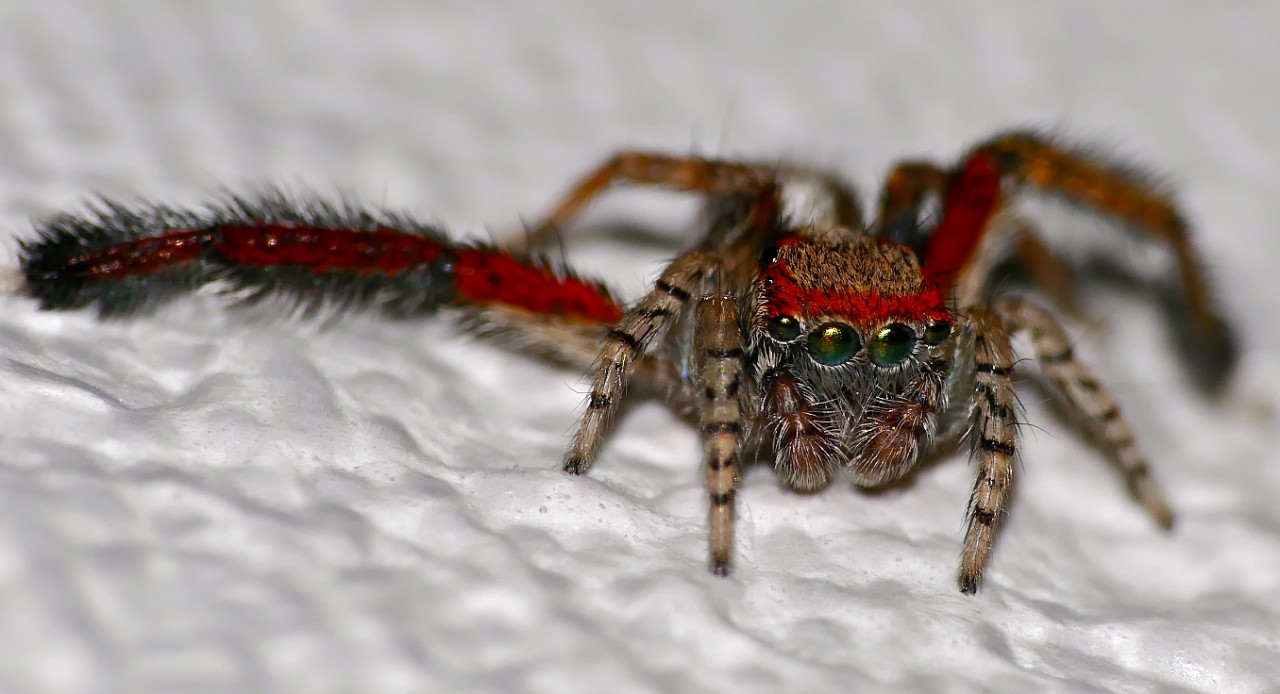
Meet a colorful but color-blind spider
One jumping spider can't see one of its most vivid colors
Jumping spiders, the flamboyant dandies of the eight-legged set, have names inspired by peacocks, cardinals and other colorful icons.
But University of Cincinnati associate professor Nathan Morehouse and an international team of researchers led by Cynthia Tedore at the University of Hamburg found that one jumping spider might have little appreciation for its own vivid splendor.
The researchers examined Saitis barbipes, a common jumping spider found in Europe and North Africa. Males have a furry red crown and legs. Their coloration seems to complement their elaborate courtship dances to woo discerning females.

David Outomuro. Photo/Provided
“We assumed they were using color for communication. But we didn’t know if their visual system even allowed them to see those colors,” said David Outomuro, a UC postdoctoral researcher now at the University of Pittsburgh.
Outomuro was first co-author of the study with Mateusz Glenszczyk, a researcher from the University of Hamburg.
Biologists collected spiders in Slovenia for lab study in Germany and used microspectrophotometry at UC to identify photoreceptors sensitive to various light wavelengths or colors. Unexpectedly, they found no evidence of a red photoreceptor. Likewise, they looked for colored filters within the eye that might shift green sensitivity to red, but found none.
Instead, they identified patches on the spider that strongly absorb ultraviolet wavelengths to appear as bright “spider green” to other jumping spiders. The red colors that are so vivid to us likely appear no different than black markings to jumping spiders.
“It’s a bit of a head-scratcher what’s going on here,” professor Morehouse said. “We haven’t solved the mystery of what the red is doing.”
The study was published in the journal The Science of Nature.

UC College of Arts and Sciences associate professor Nathan Morehouse worked with a team of international partners to examine the color vision of a jumping spider. Photo/Jay Yocis/UC Creative + Brand
Animals use color in all sorts of ways, including camouflage, warning potential predators of their toxicity, showing off to potential mates or intimidating rivals. But it’s not always apparent what bright colors might signify, Morehouse said.
“We spent a lot of time talking about it as a group. What else could it be? I feel there’s an interesting story behind the mystery,” he said.
The results were surprising, said senior study author Tedore, a research associate at the University of Hamburg.
“Males have bold red and black coloration on their forward-facing body surfaces which they display during their courtship dances; whereas, females lack red coloration altogether,” she said. “This initially suggested to us that the red color must play some role in mate attraction.
“Instead, we found that red and black are perceived equivalently, or nearly so, by these spiders and that if red is perceived as different from black, it is perceived as a dark ‘spider green’ rather than red,” Tedore said.
The spider’s red and black colors might improve defensive camouflage, the study suggested.
“For predators with red vision, at natural viewing distances, the spider's red and black color patches should blur together to become an intermediate orangish-brownish color, which would help the spider blend in with its leaf litter habitat better than all-black coloration would,” Tedore said.

UC associate professor Nathan Morehouse demonstrates how researchers use microspectrophotometry to examine the color vision of jumping spiders. Photo/Jay Yocis/UC Creative + Brand
Many colorful jumping spiders see red perfectly well. And paradoxically, some drab-colored spiders also have excellent color vision.
“We thought it would be a tidy project. Colorful spiders can see many colors,” researcher Outomuro said.
But this discovery, Morehouse said, is a reminder of how animals can sometimes perceive the world in ways far different from us. For example, sunscreen absorbs ultraviolet light extremely well, but we never notice because we can’t see that spectrum.
“If aliens were to study us, they might ask, ‘Why did they paint their bodies with strongly UV absorbing colors when they went on the beach?’ We have no perception of ultraviolet light, so we have no idea we’re creating these strong colors when we put sunscreen on,” Morehouse said.
Morehouse is director of UC’s new Institute for Research in Sensing, which examines the way we and other animals perceive the world.
“What does a wind turbine or a car window or a high-rise look like to a bird that might run into it?” he asked.
“We need to consider their perceptual worlds to coexist. But I also think it’s inherently fascinating to imagine our ways into the lives of animals that experience the world in a way that is completely alien to us.”
Featured image at top: An international team of researchers examined the color vision of the brightly colored jumping spider Saitis barbipes. Photo/Bernard Dupont/Wikimedia Commons

Color contrasts that may be visible to the male jumping spider Saitis barbipes, left, compared to birds and people, right. Instead of the vivid red we see on its face and legs, the jumping spider sees a brilliant "spider green." Graphic/Mateusz Glenszczyk and Cynthia Tedore
Become a Bearcat
Whether you’re a first-generation student or from a family of Bearcats, UC is proud to support you at every step along your journey. We want to make sure you succeed — and feel right at home.
Related Stories
There once was a biologist who talked to spiders …
July 9, 2025
UC biologist and spider expert Nathan Morehouse helped a writing collaboration at Kent University explore our common ground with these eight-legged creatures that fascinate us.
Murals boost Cincinnati’s vitality, community development
July 9, 2025
Murals have a social and economic impact, says a new study by Hyesun Jeong, assistant professor of urban design in UC's College of Design, Architecture, Art, and Planning.
Veterans urge mindfulness with fireworks
July 8, 2025
Spectrum News 1 and WCPO coverage of UC Veterans Programs & Services in conjunction with Independence Day. Interviews with UC's program director Terence Harrison and veteran-student Crystal Merino.
